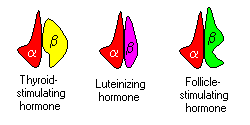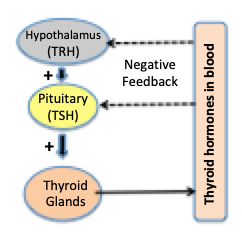VIVO Pathophysiology
Thyroid-Stimulating Hormone (Thyrotropin)
Thyroid-stimulating hormone, also known as thyrotropin, is secreted from cells in the anterior pituitary called thyrotrophs, finds its receptors on epithelial cells in the thyroid gland, and stimulates that gland to synthesize and release thyroid hormones.

TSH is a glycoprotein hormone composed of two subunits which are non-covalently bound to one another. The alpha subunit of TSH is also present in two other pituitary glycoprotein hormones, follicle-stimulating hormone and luteinizing hormone, and, in primates, in the placental hormone chorionic gonadotropin. Each of these hormones also has a unique beta subunit, which provides receptor specificity. In other words, TSH is composed of alpha subunit bound to the TSH beta subunit, and TSH associates only with its own receptor. Free alpha and beta subunits have essentially no biological activity.
 The most important controller of TSH secretion is thyroid-releasing hormone. Thyroid-releasing hormone is secreted by hypothalamic neurons into hypothalamic-hypophyseal portal blood, finds its receptors on thyrotrophs in the anterior pituitary and stimulates secretion of TSH.
The most important controller of TSH secretion is thyroid-releasing hormone. Thyroid-releasing hormone is secreted by hypothalamic neurons into hypothalamic-hypophyseal portal blood, finds its receptors on thyrotrophs in the anterior pituitary and stimulates secretion of TSH.
One interesting aspect of thyroid-releasing hormone is that it is only three amino acids long. Its basic sequence is glutamic acid-histidine-proline, although both ends of the peptide are modified.
Secretion of thyroid-releasing hormone, and hence, TSH, is inhibited by high blood levels of thyroid hormones in a classical negative feedback loop.
Additional information about TSH and its effects and control are presented in the section on the thyroid gland.
Updated 2018. Send comments to Richard.Bowen@colostate.edu

